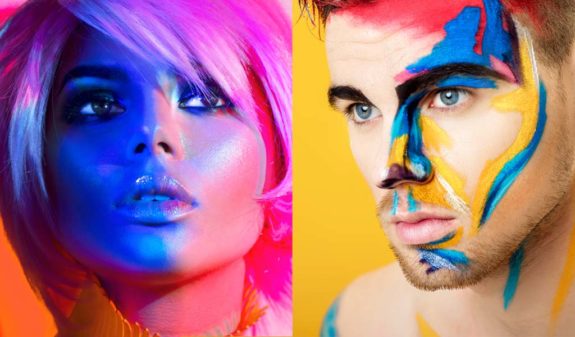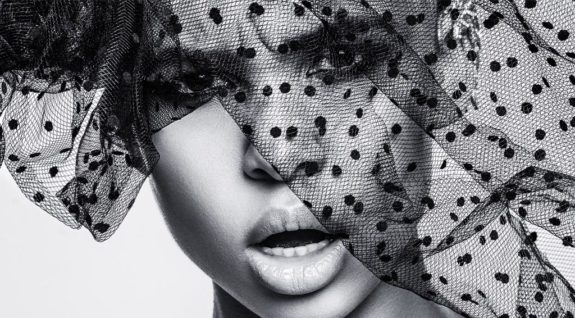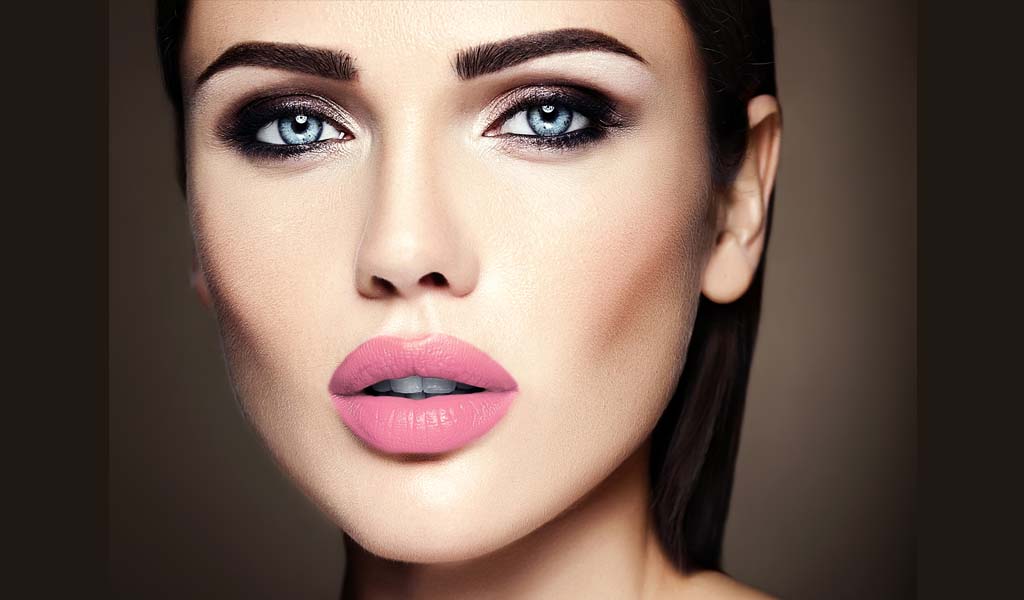
When looking in the mirror, your eyes are drawn towards your face; therefore, you might ask, “What color should I wear for my complexion?”
The theory that has been advanced over the years is that the color of your skin dictates the colors that are appropriate for you to wear and to surround yourself with throughout your lifetime. This misconception has created confusion and cast doubts over whether that color analysis is an accurate protocol.
C Color® counsels that your complexion or any external feature, for that matter, is not a precursor to ascertaining the colors that can enable you to look your best. Rather, these determinants reside within your DNA.
C Color Teaches You To Look Inside For Color

The Myth Regarding Complexion As A Factor In Color Consulting
The majority of color theories and consultants purport that external features such as hair colors, eye colors, and complexion colors determine the category of colors that appear the best on you.
The challenge with the “external features” color theory is that it does not follow a linear or logical sequence; thereupon, making the system difficult to make sense of or follow.
There are a multitude of colors that embody your hair, eye, and complexion colors. Your complexion is not necessarily one specific color, such as red, pink, yellow, green, or another undertone. Your skin, the largest organ of your body, is created with a myriad of colors. Appropriately, your hair consists of a variety of colors, and your eyes do as well.
Correspondingly, it is impossible to verify the exemplary colors that a person should wear and surround themselves with, stemming from their external features.
Rethink The Colors That Enhance Your Appearance: Introducing The C Color® Theory
The C Color® Ideology was founded on the belief that there is a color gene within your DNA. Consequently, the Methodology focuses on the internal, rather than the external. C Color® does not take external features, such as hair colors, eye colors, or skin colors into consideration, as these components are irrelevant when determining your immanent color inclinations.

C Color® theory differs from all other color theories and color companies, as C Color® is the first and only company to quantify intuitive color proclivities. The revolutionary C Color Ideology is linear, can be logically followed, takes into account the 16.7 million hex codes or known identified colors in the world, and offers a Methodology that is quick, simple, and effective.
Quantifying intuitive color preferences is the specialty of our lifestyle technology company.
The C Color® Ideology and Methodology make sense, will support you in living life in your unparalleled color environment, and can enable you to look, think, feel, act, learn, and heal your best.
Your C Color Spectrum® is deduced by tapping into your intrinsic predispositions. A C Color Spectrum® is a collection of millions of hues that beautifies the appearance of those individuals that are within that C Color Spectrum®.
C Color® has classified the populous colors in the world into four C Color Spectrums. These colors are categorized by the temperature, saturation, and predominant base of the color, which is one of the primary colors of either blue, yellow, or red.
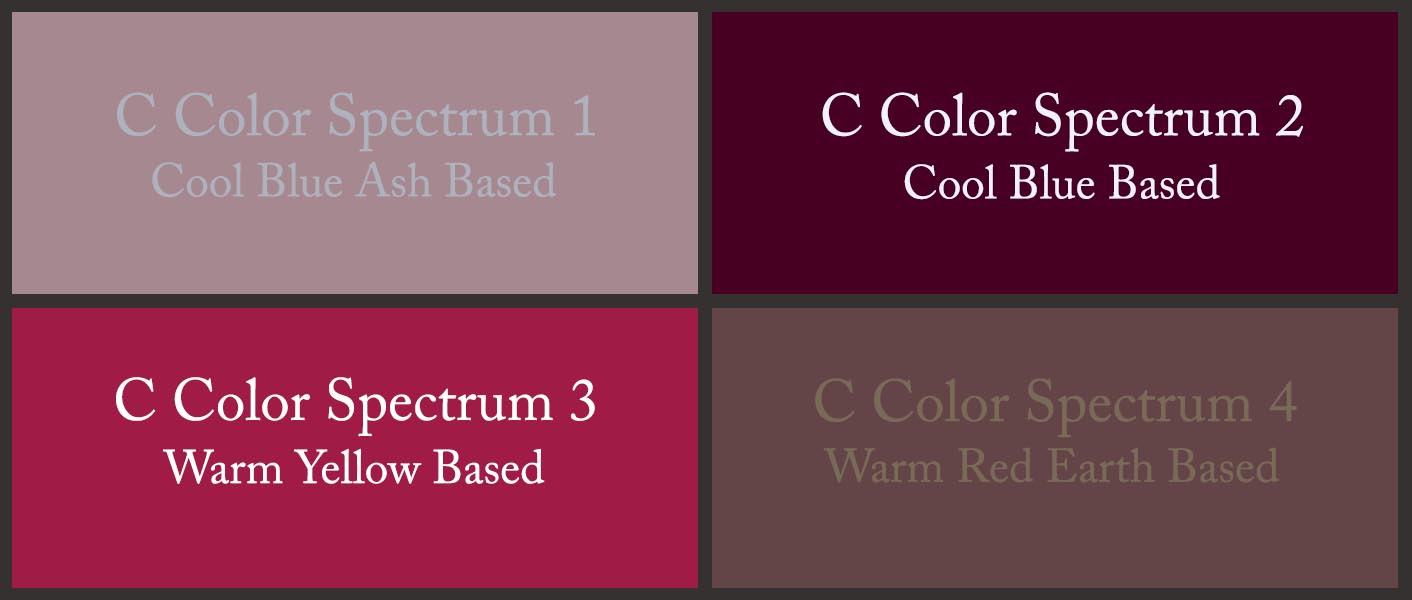
The above color quadrant displays a Cool Blue Ash Based red color, a Cool Blue Based burgundy color, a Warm Yellow Based red color, and a Warm Red Earth Based red color, as examples to further distinguish the four C Color Spectrums. Each C Color Spectrum® contains millions of every color.
When you choose and wear the colors from your C Color Spectrum®, you are following an instinctive trait and that results in a glowing and flawless complexion and an elevated persona that people find attractive.
While C Color was established from scientific thought, the consequence of our color expertise is ultimately an outward expression of what is inside of all of us.
Below are examples of cosmetic colors for each of the four C Color Spectrums.
Please note that cosmetic colors are for reference only and do not represent the models’ C Color Spectrums.
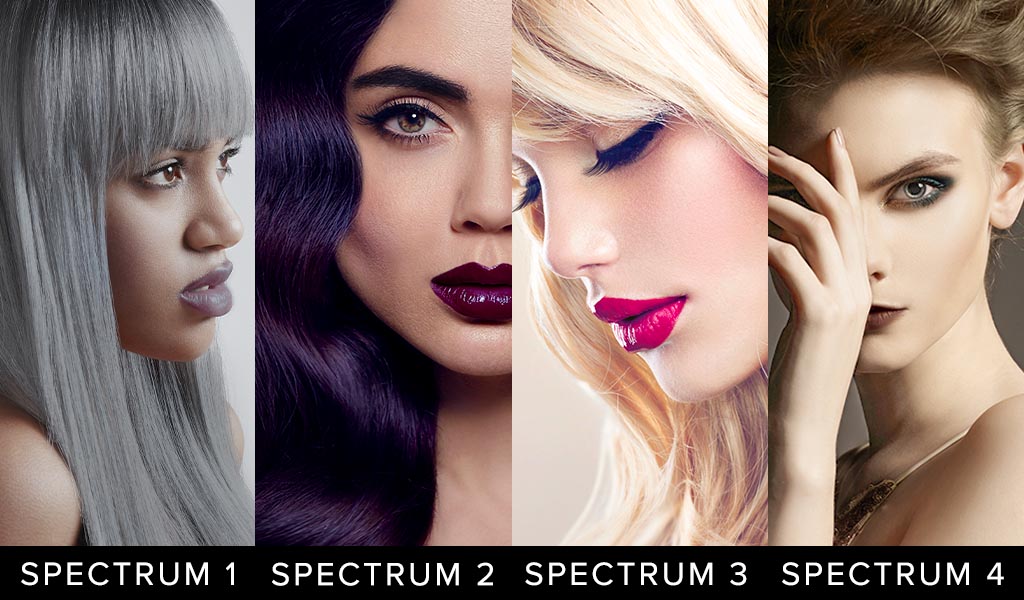 UTILIZE THE C COLOR APP TO CONFIRM YOUR C COLOR SPECTRUM COLORS
UTILIZE THE C COLOR APP TO CONFIRM YOUR C COLOR SPECTRUM COLORS
Notice the differences in the four C Color Spectrums:
- C Color Spectrum 1 Lavender is Cool Blue Based, Less Saturated, Appears Rubbed with Ash
- C Color Spectrum 2 Burgundy is Cool Blue Based, More Saturated
- C Color Spectrum 3 Raspberry is Warm Yellow Based, Moderately Saturated
- C Color Spectrum 4 Brown-Burgundy is Warm Red Based, Less Saturated, Appears Rubbed with Earth
The key to the classification of all colors is the temperature, saturation, and predominant base of one of the primary colors of blue, yellow, or red.
People often confuse the temperatures, saturations, and predominant bases of colors. Color analysts, makeup artists, stylists, designers, and most other industry professionals categorize blues, greens, and purples as cool colors and reds, yellows, and oranges as warm colors; nevertheless, all colors can be cool or warm.
Your Optimal Complexion Colors
Have you ever seen a person who you cannot stop yourself from staring at and you are unsure as to why that is the case?
Chances are that person is clad in their inherent gene/DNA colors.
Below is an example of a model in both C Color Spectrum 1, which is predominantly Cool Blue Ash Based, and C Color Spectrum 3, which is predominantly Warm Yellow Based.
Distinctively, when the model is clad in C Color Spectrum 3 colors, she has a flawless and glowing complexion, as the model, in reality, is within the C Color Spectrum 3 category.
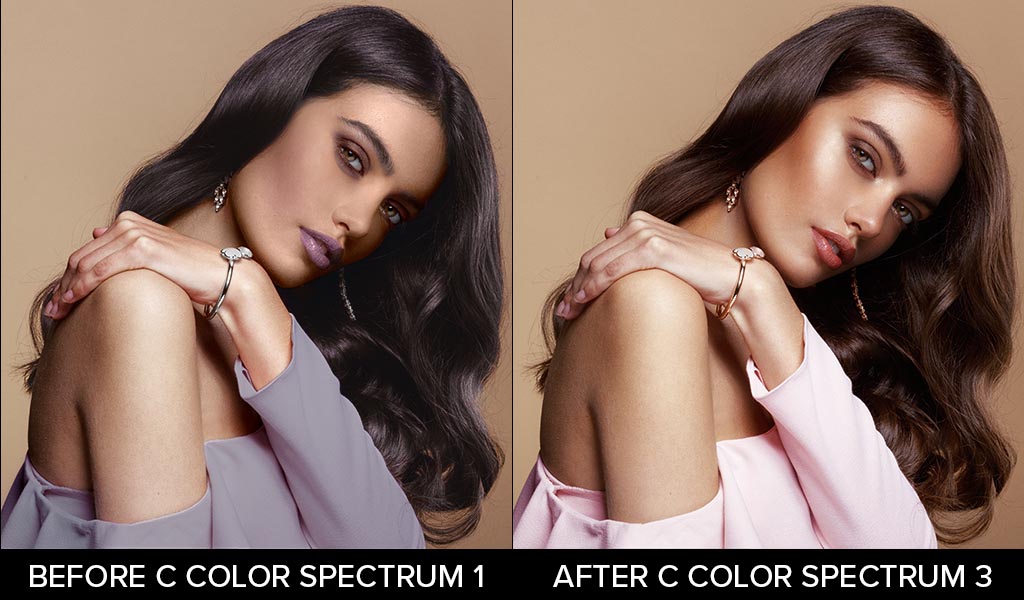 The After Photograph Displays Yellow Based Hair, Makeup, and Dress, Resulting In C Color Spectrum 3
The After Photograph Displays Yellow Based Hair, Makeup, and Dress, Resulting In C Color Spectrum 3
The key to the classification of all colors is the temperature: cool or warm, saturation: less, more, or moderate, and predominant base of a primary color: blue, yellow, or red.
On the other hand, if the colors are not in the person’s C Color Spectrum, then the colors will wear them. In other words, you will notice the colors, not the person, as the colors will drain the life from their skin.
Think about people who appear tired, washed out, or, simply stated, rather invisible. You can be assured that those individuals are not clad in their DNA sanctioned colors.
People with similarly colored complexions can appear drastically different in certain hues, as complexion is not a part of authenticating the superlative colors for an individual.
A beautiful young woman from Madrid who happened to be a C Color Spectrum 3, told the C Color Founder that she thought that if she wore all black, people would be more inclined to notice her face.
That belief would have been true if this young woman was determined to be within another C Color Spectrum; however, that was not the case.
In fact, it is the exact opposite, unless the color black was created with a warm, predominantly yellow base, as that is the predominant base of C Color Spectrum 3 and appeared to be more of a “gunmetal” hue, the black color would drain the life from her skin, and she would appear invisible. Hence, the reverse of being noticed.
Thereupon the fitting hair colors and cosmetic colors are of the utmost importance, as these colors are either on or near the face. Accessory colors are also significant, as earrings, necklaces, and scarves are worn near the face.
That being said, individuals can wear cosmetic colors or don accessories that transcend boundaries, such as the latest colors of the season or current trends, as colors that are aligned with your C Color Spectrum will guarantee a radiant appearance.
Below are examples of how individuals from each of the four C Color Spectrums can wear light pink, raspberry, pink, and clay colors.
Please note that clothing and accessory colors are for reference only and do not represent the models’ C Color Spectrums.
NOTE: THIS COMPOSITE IS BEING UPDATED FOR COLOR ACCURACY
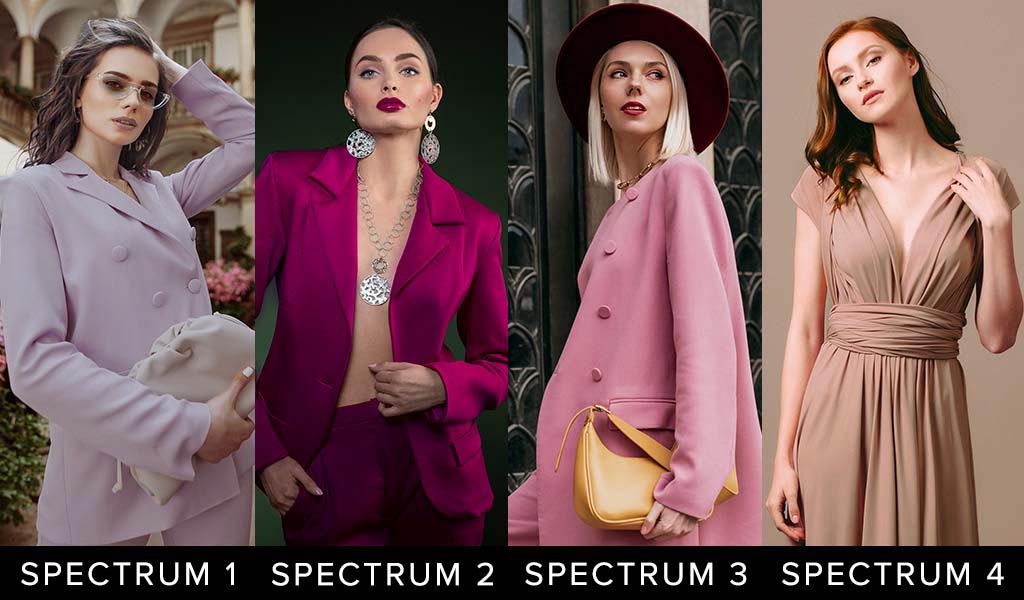 UTILIZE THE C COLOR APP TO CONFIRM YOUR C COLOR SPECTRUM COLORS
UTILIZE THE C COLOR APP TO CONFIRM YOUR C COLOR SPECTRUM COLORS
Notice the differences in the four C Color Spectrums:
- C Color Spectrum 1 Light Pink is Cool Blue Based, Less Saturated, Appears Rubbed with Ash
- C Color Spectrum 2 Raspberry is Cool Blue Based, More Saturated
- C Color Spectrum 3 Pink is Warm Yellow Based, Moderately Saturated
- C Color Spectrum 4 Clay is Warm Red Based, Less Saturated, Appears Rubbed with Earth
The key to the classification of all colors is the temperature, saturation, and predominant base of one of the primary colors of blue, yellow, or red.
In General, The Color Pink Does Not Appeal To Individuals Within C Color Spectrum 4; Thereupon, The Color Of Clay Is Displayed
Take The C Color® Quiz To Determine Your C Color Spectrum®
To establish your natural desire for color and your C Color Spectrum, simply take the five-minute C Color Quiz.
The C Color® Quiz is quick, effective, and attests to which one of the four C Color Spectrums® that you belong. With the C Color Quiz, you are guided through a series of nine panels, each displaying four quadrants of colors. The objective is to select the color quadrant that immediately catches your eye, thereby ensuring that you are following your intuition when choosing your color selections, not your thought choices, as the latter will skew the aftereffect.
Due to this reason, receiving a Personal C Color Analysis differs from all others on the market.
The efficacy of the C Color Quiz is 99.8%. We do not guarantee hundred percent efficacy, as clients may not consistently follow their innate preferences or intuition throughout the C Color Quiz.
The C Color App benefits you by verifying your consummate colors.
- All colors contain numerous colors; accordingly, it is essential to photograph the item that you are considering at a distance and to color correct the photograph with the Lighting and Filters features.
- The photographed color must match the color of the actual item that the eyes see.
- Once the above two steps are completed, choose a zoomed in section of the pure color, even if blurred to match, and the C Color App will reveal whether or not the color is within your C Color Spectrum®.
- The built-in capability of the Smartphone to lighten or darken the photograph can be used, if necessary.
- Avoid bright areas and shadowed areas, as those conditions can affect the color match.
The zooming capacity of the C Color Matching Technology has been embellished to allow for greater accuracy. This improvement ensures that the purest color of the article to be matched can be identified more proficiently and opportunely.
The C Color App has been upgraded to include a color matching Instructional Video, C Color Courses, C Color E-Books, and C Color Spectrum Virtual Color Galleries.
C Color Spectrum Virtual Color Galleries within the C Color App were developed as a vantage point for you from which to better understand the colors within your C Color Spectrum.
The C Color App is a comprehensive color palette that identifies the limitless number of colors that are available to you. These colors are all from within your C Color Spectrum. Aptly, the C Color Spectrum Virtual Color Galleries are supplemental to the C Color App.
The C Color App, as the 21st Century Palette and Color Consultant, is at your fingertips and directs you in choosing the incomparable color choices, predicated upon your latent DNA predispositions.
Please be sure to visit the C Color Website.
The refreshed C Color Website includes a plethora of engaging content, simple navigability, and instructive visuals representative of each C Color Spectrum.
Browse the C Color Website and C Color Blog Posts for a colorful experience and inspiration regarding all things color.
C Color® has an online store to further direct you in your endeavor with colors.
C COLOR COORDINATES
Interchangeable Colors And Patterns In Your C Color Spectrum Developed As Examples For Fashion And Décor
Prerequisite: C Color Quiz
Palettes are supplemental to the C Color App
Discover Thousands Of Colors That Will Adorn Your Complexion
The favorable news is that there is an endless number of colors in the world, and you have access to millions of colors with the C Color® App.
The optimal colors not only enhance your complexion and appearance but can also enable you to think more clearly, can produce feelings of well-being, can motivate you to act your best, can assist you in absorbing new concepts more readily and distinctly, and can aid you in healing.
C Color is an Amazon Influencer. The products offered in the C Color Blog Post are certified to be within C Color Spectrum 3.
C COLOR CURATED PRODUCTS
Coordinated And Interchangeable Products In C Color Spectrum 3
If products are unavailable, Amazon will suggest substitute products. The C Color App will verify if these products are within your C Color Spectrum.
As an Amazon Influencer, C Color earns from qualifying purchases.
Uncover The “Key To Success” With Color By Utilizing The C Color® App
The “Key To Success” is to be aware that the temperature, saturation and predominant base of the color matters, although, in most cases, these three factors are indiscernible to the eye.
The beauty of the C Color App is that the C Color Methodology has been designed to identify the temperature, saturation, and predominant base of colors for you.
Below are examples of how individuals from each of the four C Color Spectrums can wear light purple, burgundy, ivory, and grape colors.
Please note that clothing and accessory colors are for reference only and do not represent the models’ C Color Spectrums.
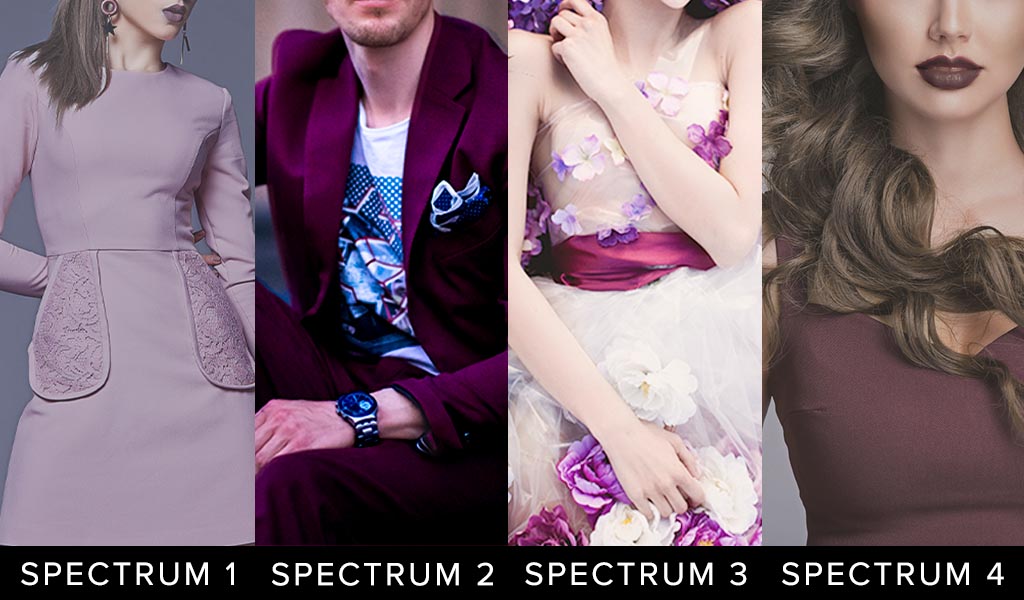 UTILIZE THE C COLOR APP TO CONFIRM YOUR C COLOR SPECTRUM COLORS
UTILIZE THE C COLOR APP TO CONFIRM YOUR C COLOR SPECTRUM COLORS
Notice the differences in the four C Color Spectrums:
- C Color Spectrum 1 Light Purple is Cool Blue Based, Less Saturated, Appears Rubbed with Ash
- C Color Spectrum 2 Burgundy is Cool Blue Based, More Saturated
- C Color Spectrum 3 Ivory is Warm Yellow Based, Moderately Saturated
- C Color Spectrum 4 Grape is Warm Red Based, Less Saturated, Appears Rubbed with Earth
The key to the classification of all colors is the temperature, saturation, and predominant base of one of the primary colors of blue, yellow, or red.
The C Color® App, as the expert Eye, is accurate, meets your color needs, answers your color questions, assists you in color decision making and saves you thousands of dollars by eliminating misguided color choices.
C Color® conquers the color conundrum and teaches you to implement color to successfully portray your genuine essence!
Look and feel prettier or more handsome; enjoy glowing skin; receive compliments; gain confidence; and garner color confidence.
C Color Gets You There!
Remember: Hair, Eye, and Skin Colors Don’t Matter
“And all the colors I am inside have not been invented yet.” …Shel Silverstein, Writer “Where The Sidewalk Ends”
The latest version of the C Color App has been tested and is verified to work on iPhone XS and above, and on Android phones with a resolution of 700×1600 or higher. Smaller devices may have restricted functionality due to screen size limitations.
©2024 C Color, LLC. All Rights Reserved.
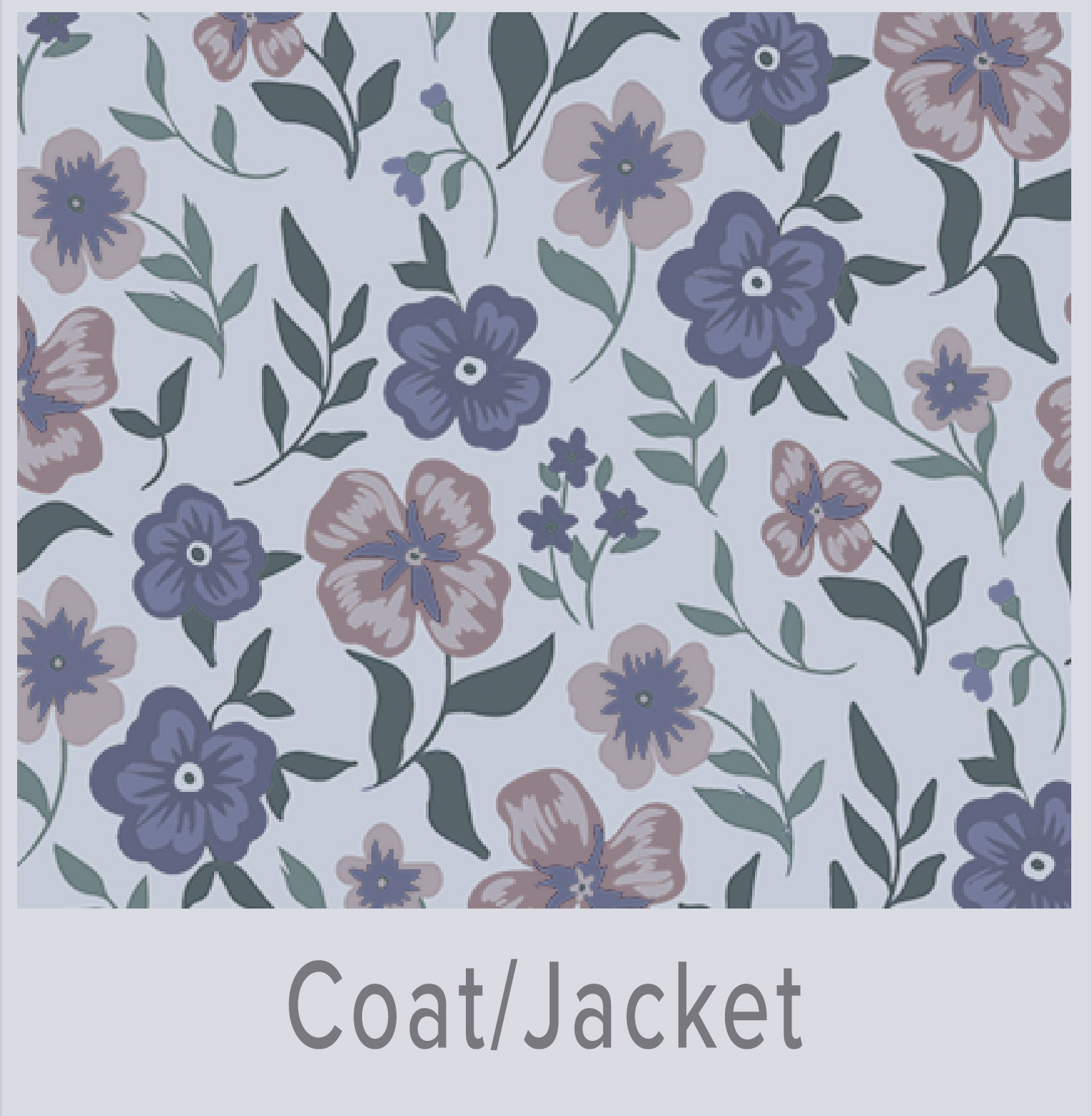 Shop C Color Spectrum 1
Shop C Color Spectrum 1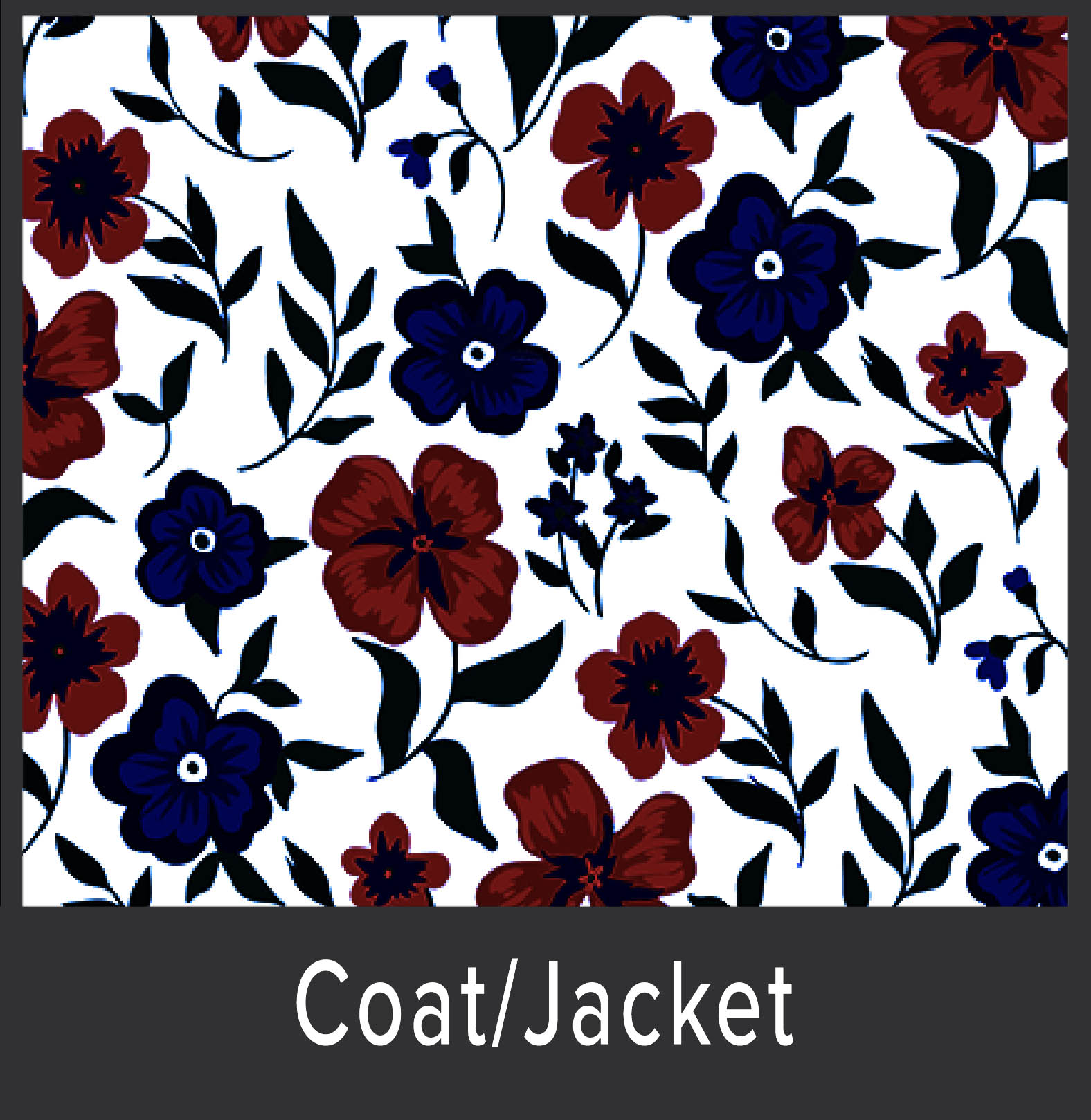 Shop C Color Spectrum 2
Shop C Color Spectrum 2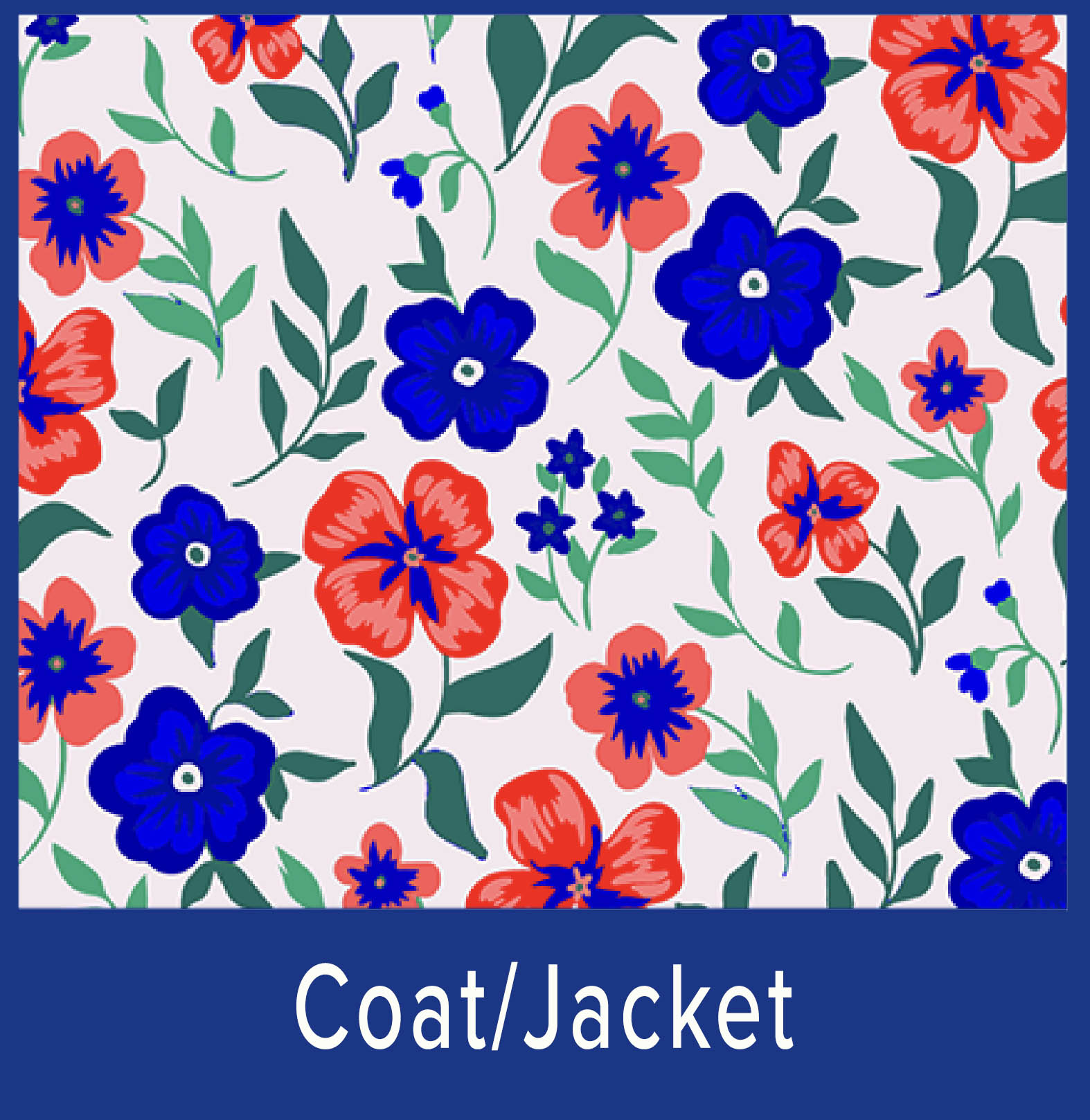 Shop C Color Spectrum 3
Shop C Color Spectrum 3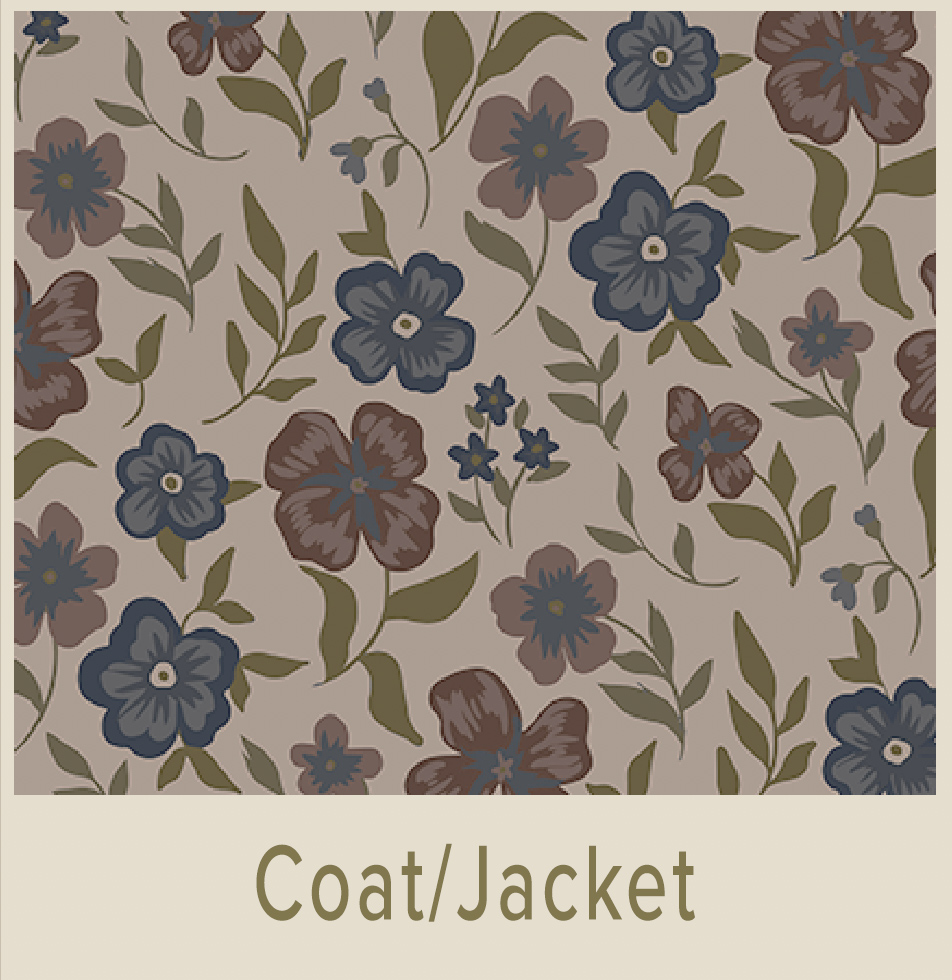 Shop C Color Spectrum 4
Shop C Color Spectrum 4
